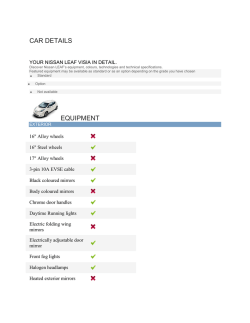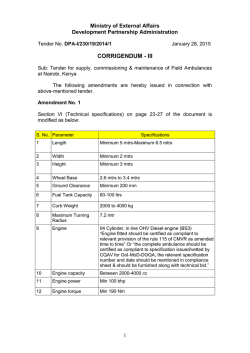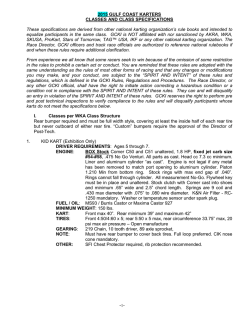
P.22 - Oman Tribune
22 MOTORING OMAN TRIBUNE WEDNESDAY, JANUARY 28, 2015 Elegant ride Merc class is evident in 2015 Mercedes-Benz C300 small luxury sedan, writes Mark Phelan T HE 2015 Mercedes-Benz C300 4Matic sets a new standard for small luxury sedans as the product planning gurus at Mercedes headquarters in Stuttgart place it right at the head of a pack of fine competitors. Prices for the C-class sedan start at $40,400 for an all-wheel-drive 4Matic model with a 241-hp 2.0L turbocharged four-cylinder engine. The C400 rear-drive comes with a 329-hp twin-turbo 3.0L V6 and starts at $48,590. All C-classes have a seven-speed automatic transmission. Mercedes expects to add a rear-drive C300 priced at $38,400 in the first quarter of 2015. Two-door C-class coupes are available, but they still use the old platform, not the 2015 sedan’s more modern engineering. I tested a C300 4Matic with a stunning interior, power sunroof, Burmester audio, blind spot alert and a sport package that combined functional upgrades like perforated front brake discs with cosmetics like a black AMG headliner. It cost $49,870. All prices exclude destination charges. The new C-class platform is about 3.7 inches longer and 1.6 inch wider than the 2014 sedan. Despite that growth, the car is 200 pounds lighter than its predecessor. About 50 per cent of the body shell is aluminum, compared to less than 10 per cent of the old car. The stiff, light body contributes to fuel economy and a quiet, comfortable ride. The 2015 C300 is nearly the same size as the less expensive CLA250 sedan Mercedes introduced last year, which starts at $29,900 for a front-wheel-drive model. The C300 is 2.2 inches longer and has 2.0 cubic feet more passenger space, according to EPA measurements. The C300 has noticeably more rear headroom and a comfortable, accommodating front seat. Both cars have small rear door openings and limited rear legroom. The C300 4Matic’s EPA fuel economy rating of 24mpg in the city, 31 on the highway and 27 combined beats the competition by as much as 4mpg in the key combined figure. The 2.0L turbo’s output is lower than the comparable A4, ATS and the Q50 and TLX’s larger V6s, but performance is satisfactory. Mercedes’ reliable seven-speed shifts quickly and smoothly. The styling is unobtrusive. The short rear deck is reminiscent of the Infiniti Q50. LED lights help offset that and give the C300 a visual identity. The ride leans more towards luxury than sportiness. Even with the optional sport suspension, the test car pillowed rough roads. The speed-sensitive steering is balanced and responsive, with good on-center feel. The interior is stunning, with the best design and materials ever in a small Mercedes. Aluminum air vents, buttons and switches look and feel terrific. The test car also had cranberry red leather upholstery and soft covers on the upper dash and doors. The controls are less satisfying. The car had voice recognition for its Garmin navigation, but not for phone calls. To select a name from my contacts or dial a number, I had to use either a touch pad or a dial in the center console, either of which required me looking a display screen rather than watching the road. That’s an unacceptable distraction, particularly in a car whose competitors offer excellent voice recognition. The C300 only gets full voice-rec if you shell out $2,690 for the optional Comand multimedia system. I found the touch pad difficult to use in a moving vehicle for other functions as well. The audio volume control suffered from an intermittent fault. It ceased to work frequently when playing CDs. The problem did not occur with other inputs like radio, iPod and streaming audio. Those are surprising and relatively elementary oversights in what’s otherwise a very good car. Don’t be surprised if Mercedes remedies them quickly and the 2015 C300 becomes even more appealing. MCT News Service More of everything The 2015 Acura RDX crossover has undergone a complete redesign, writes G. Chambers Williams III N OW in its third year since a complete redesign, the 2015 Acura RDX compact crossover continues as an upscale family hauler that’s not much more expensive than some nonpremium competitors. Acura aimed the RDX at young professional couples with no kids, and also at empty-nester baby boomers looking to downsize a bit from the bigger SUVs they needed when all the kids were at home. For 2015, RDX prices begin at $34,895 (plus $895 freight) for the front-wheel-drive version, and $36,295 with all-wheel drive. With the Technology package, the frontdrive model is $38,595, and the allwheel-drive $39,995. The RDX is in the entry-premium SUV segment, competing against vehicles such as the Audi Q5, BMW X3, Infiniti QX50, Mercedes-Benz GLK350, Volkswagen Tiguan and Volvo XC60. Even with gasoline prices down dramatically in recent weeks, sales of these compact crossovers, including premium models, are still climbing as consumers look for smaller vehicles with better fuel economy. Buyers in this class are looking for more of everything, including fuel economy, luxury and performance -- but in smaller packages. Introduced originally for 2007, the five-passenger RDX is based on the architecture of popular CR-V compact crossover, which got its own slight makeover for 2015. This RDX is based on the current CR-V, but the chassis has been stretched a bit. It’s about five inches longer than the CR-V, two inches wider, and an inch taller. The RDX’s wheelbase is about two inches longer, as well, which helps give it a smoother ride. Exterior styling is sporty, especially in the front. The rear wasn’t changed much, so it still looks quite a bit like the CR-V. Overall, the vehicle remains easily recognizable as an RDX, but side by side with a CR-V, you can see the similarities. The RDX’s biggest difference from the CR-V is under the hood. While the Honda comes with a four-cylinder engine, the RDX is offered only with a pleasingly peppy V-6. Gone is the previous model’s turbocharged fourcylinder, but fuel economy was increased from the previous generation. For 2015, the front-drive model has EPA ratings of 20 mpg city/28 highway/23 combined; with all-wheel drive, the numbers are 19/27/22. The 3.5-liter engine is rated at 273 horsepower and 251 foot-pounds of torque, and is paired with a six-speed automatic transmission with manualshift feature, activated by paddles behind each side of the steering wheel. Our tester, the EX-L trim, had the optional all-wheel-drive system, which is borrowed from the CR-V. It’s not the nicer Super-Handling All-Wheel Drive from the previous RDX, which is still found on more-expensive Acura models. Four-wheel-drive mode operates automatically, with no input necessary from the driver. Power normally is directed to the front wheels until wheel-slippage is detected. Then, as needed, up to half of the torque can be transferred to the rear wheels. There is no low-range gearing for serious off-road driving, though, nor is there a locking differential to allow the driver to force the power to the rear. This RDX has a much more luxurious interior than that of the CR-V, with standard leather upholstery and other amenities that clearly put the vehicle in the premium class. The cabin also is much quieter than before, thanks to better insulation and Active Noise Control technology -- similar to those noise-cancelling headphones people wear on airplanes. The vehicle also has larger door openings, more passenger and cargo space, and new features such as an optional power-operated tailgate, which makes it much easier to open and close when your hands are full. MCT News Service
© Copyright 2025



